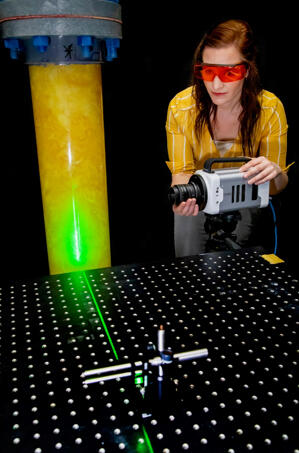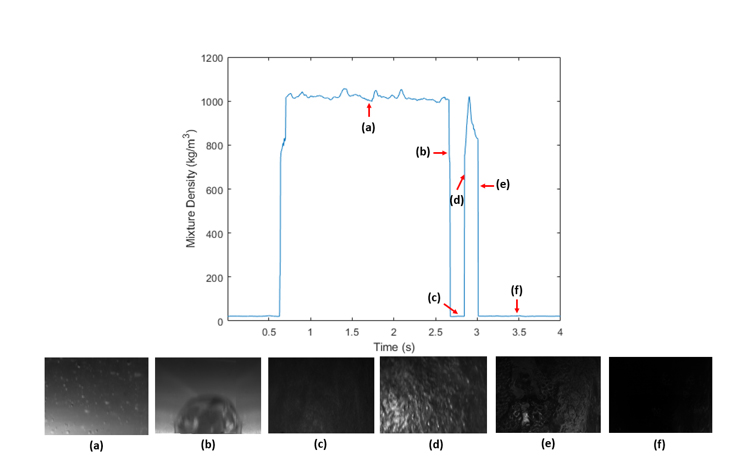Background
Planar laser-induced fluorescence (PLIF) is a flow visualization technique that has been previously used for measuring the densities of single-phase and some two-phase flows in fundamental research settings using a high-speed camera, laser source, and test fluids that are marked with dye. However, the use of this technique to obtain mixture properties for the simultaneous flowing of gas, water, and oil is challenging and has previously not been accomplished without a large degree of error. During three-phase equipment performance tests, reference instrumentation is implemented so that the initial flowing conditions supplied to the equipment being evaluated are known. However, most test conditions are transient in nature, and although the single-phase input flowing conditions are monitored, the interaction and co-mingling of the different fluid streams once they reach the vendor’s equipment may be vastly different (e.g., fluid flow patterns).
Currently, reference measurement techniques or equipment for measuring the instantaneous or time-history of the density or concentration of single-phase and two-phase flows exist. However, there is no measurement technique or piece of equipment that is commercially available that can be used to obtain a species concentration or density reference measurement for three-phase flows. Therefore, there is a need to improve upon current PLIF measurement techniques so that a time-resolved three-phase flow density reference measurement can be integrated for future testing programs.
Approach

Figure 1: The tests were conducted in a temporary test facility, which was designed to produce both two-phase and three-phase flows vertically upward, and contained a dedicated transparent test section that created a large optical viewing access to conduct the PLIF measurements as shown in this figure.
The objective of this project was to obtain the time-resolved density and species concentration of three-phase (oil, water, and gas) flows using an improved PLIF measurement technique. To meet this objective, a combination of a testing program and different image processing techniques was undertaken.
The tests were conducted in a temporary test facility, which was designed to produce both two-phase and three-phase flows vertically upward, and contained a dedicated transparent test section that created a large optical viewing access to conduct the PLIF measurements as shown in Figure 1. Camera filter changes were first attempted with two-phase water-gas flows, where the recorded images were processed using a threshold spatial-averaging technique to obtain a density value but with incremental algorithm adjustments using pre-processing and post-processing techniques. When the best combination of experimental and image processing techniques that provided the best density output result was discovered for the two-phase water and gas flows, the same combination of approaches was validated against water-oil flows and then finally water-oil-gas flows.
Accomplishments
The results from this study, example results shown in Figure 2, indicate that the PLIF measurement technique was successfully optimized for various three-phase steady-state and transient flows in a vertically orientated 6-inch diameter pipe. A combination of using a pink color-correcting camera lens filter, high-spatial frequency filtering, and a Gaussian window provided the best mixture density output from the PLIF measurement system. The pink camera lens filter reduced up to 97% of the light refractions coming off the gas phase. The time series transient condition results indicate that the optimized PLIF measurement approach was able to capture more of the flow features than the two-phase reference measurement instruments used during the testing program.

Figure 2: Example results from this study indicating that the PLIF measurement technique was successfully optimized for various three-phase steady-state and transient flows in a vertically orientated 6-inch diameter pipe.

